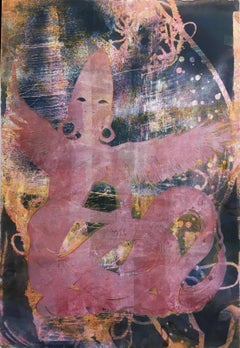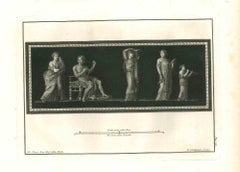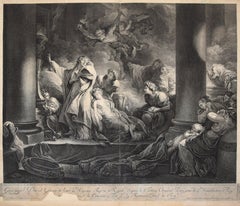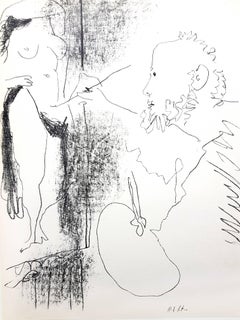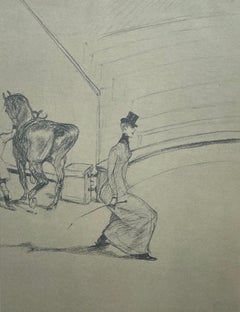Bride Figurative Prints
to
1,672
4,343
1,298
887
291
143
Overall Width
to
Overall Height
to
2,713
941
613
592
150
140
125
81
43
32
17
6
5
316
131
77
70
69
945
1,549
4,057
449
88
160
295
242
212
364
623
787
271
125
778
4,772
2,034
150
26,967
14,780
10,580
9,095
7,789
7,000
4,597
4,163
2,411
2,047
1,934
1,865
1,664
1,470
1,465
1,443
1,436
1,300
1,228
1,110
2,830
2,525
781
490
418
476
4,025
3,591
2,003
Art Subject: Bride
Naga Kanya, 2018, monoprint, fantasy, marbled rag paper, pink, purple, blue
By Loren Abbate
Located in Jersey City, NJ
Monoprint & hand embellishment on paper. Naga Kanya, 2018, monoprint, fantasy, marbled rag paper, pink, purple, blue
Category
2010s Contemporary Figurative Prints
Materials
Paper, Rag Paper, Monoprint
Ancient Roman Fresco - Original Etching by Pietro Campana - 18th Century
Located in Roma, IT
Ancient Roman Fresco, from the series "Antiquities of Herculaneum", is an original etching on paper realized by P. Campana in the 18th century.
Signed on the plate, on the lower rig...
Category
18th Century Old Masters Figurative Prints
Materials
Etching
Le Grand prêtre Coresus - Etching by J- Danzel - Late 18th Century
By Jérôme Danzel
Located in Roma, IT
Le Grand prêtre Coresus is an artwork realized by Jérôme Danzel in the second half of the XVIII Century.
Burin after Fragonard's artwork "Coresus et ...
Category
Late 18th Century Modern Figurative Prints
Materials
Etching
Surrealist Character with a Fish - Original handsigned lithograph
Located in Paris, IDF
Lucien COUTAUD
Surrealist Character with a Fish, 1966
Original lithograph
Handsigned in pencil
On Rives vellum 37 x 28 cm (c. 15 x 11 inch)
Excellent condition
Category
1960s Modern Figurative Prints
Materials
Lithograph
"Le Peintre et son Modèle" - Original Lithograph
Located in Collonge Bellerive, Geneve, CH
Original Lithograph - Pablo Picasso
"Le Peintre et son Modèle" - Original Lithograph from "Picasso Lithographe IV"
Dimensions: 32 x 25 cm
1964...
Category
1960s Modern Figurative Prints
Materials
Lithograph
Toulouse-Lautrec, Composition, Henri de Toulouse-Lautrec, At the Circus (after)
Located in Fairfield, CT
Medium: Lithograph on vélin paper, hinged on archival backing paper, as issued
Year: 1967
Paper Size: 17.32 x 14.17 inches (backing paper size)
Inscription: Signed in the plate and u...
Category
1940s Post-Impressionist Figurative Prints
Materials
Lithograph
$716 Sale Price
20% Off
Ipse Coniungat Vos - Lithograph by Salvador Dalí - 1964
Located in Roma, IT
Ipse coniugant vos ("May he himself join you in Marriage") is an artwork realized in 1964.
It is part of Biblia Sacra vulgatæ editionis published by Rizzoli-Mediolani between 1967 ...
Category
1960s Surrealist Figurative Prints
Materials
Lithograph
$411 Sale Price
40% Off
Composition, Vers un monde volage, Marcel Gromaire
Located in Southampton, NY
Etching on vélin d'Arches paper. Unsigned and unnumbered, as issued. Good condition. Published by Éditions Marcel Seheur, Paris; printed by Atelier d'art Paul Haasen, Paris, Septembe...
Category
1920s Modern Figurative Prints
Materials
Etching
$1,436 Sale Price
20% Off
Judith & Holophernes - Etching by J.P.M. Jazet after H. Vernet - 19th Century
Located in Roma, IT
Judith & Holophernel is an original engraving, realized by Jean-Pierre-Marie Jazet after a painting of Horace Vernet.
In very good conditions.
The artwork represents the key scene of the story of Judith and Holophernes.
Horace Vernet (1789 -1863): The French painter of military and historical scenes Horace Vernet was born on 30 June 1789 in Paris at the Louvre, where his parents found refuge during the war. The artist mainly painted sports subjects and extensive battle scenes. Son and grandson of two well-known painters, Carle Vernet and Joseph Vernet, Horace developed a remarkable facility for working on a large scale making him one of the most important painters of military France. In favor of Napoleon Bonaparte, the painter specialized in glorifying the Napoleonic era with his art. During the restoration of the monarchy after 1815, his studio became a center of political intrigue, as well as a meeting place for sportsmen, artists and writers. One of his most famous paintings dates back to 1826, Battle of the Bridge of Arcole, and shows the young Napoleon grabbing a torn flag and leading his men across the bridge on November 17, 1796. After spending a period with the French army in Algiers (1833), Horace Vernet's works present elements of the Arab world. Later he also obtained commissions from Louis Philippe and Napoleon III to produce battle scene paintings...
Category
19th Century Old Masters Figurative Prints
Materials
Etching
Rembrandt, Composition, Rembrandt, Drawings from the Bible (after)
Located in Fairfield, CT
Medium: Lithograph on vélin Hamilton Kilmory paper
Year: 1947
Paper Size: 9.5 x 12.5 inches
Inscription: Unsigned and unnumbered, as issued
Notes: From the folio, Rembrandt, Drawings...
Category
1940s Baroque Figurative Prints
Materials
Lithograph
$716 Sale Price
20% Off
Melanie Schiele
By Egon Schiele
Located in Roma, IT
This lithograph from the portfolio "Egon Schiele" is a reproduction of "Melanie Schiele", an original artwork realized by Egon Schiele in 1906. The portfolio, that includes 10 lithog...
Category
1910s Modern Figurative Prints
Materials
Lithograph
Art Card: "Joan Crawford Says", 1964 postcard (hand signed by James Rosenquist)
Located in New York, NY
James Rosenquist
Art Card: "Joan Crawford Says", 1964 (hand signed by James Rosenquist), ca. 1980
Offset lithograph postcard (Hand Signed by James Rosenquist)
Boldly signed by James ...
Category
1960s Pop Art Portrait Prints
Materials
Postcard
Le Bouquet de Violettes (The Bouquet of Violets) /// Figurative Impressionist
By Manuel Robbe
Located in Saint Augustine, FL
Artist: Manuel Robbe (French, 1872-1936)
Title: "Le Bouquet de Violettes (The Bouquet of Violets)"
*Signed by Robbe in pencil lower right
Year: 1903
Medium: Original Hand-Colored Etc...
Category
Early 1900s Post-Impressionist Figurative Prints
Materials
Watercolor, Laid Paper, Etching, Aquatint, Intaglio
Henri Matisse, Fusain, from Drawings by Henri Matisse, 1925 (after)
Located in Southampton, NY
This exquisite lithograph after Henri Matisse (1869–1954), titled Fusain (Charcoal), from the album Dessins de Henri-Matisse (Drawings by Henri Matisse), originates from the 1925 edi...
Category
1920s Modern Landscape Prints
Materials
Lithograph
$956 Sale Price
20% Off
The Soldier's Ballad - Lithograph by Max Ernst - 1972
By Max Ernst
Located in Roma, IT
The Soldier's Ballad is a contemporary artwork realized by Max Ernst in 1972.
Mixed colored lithograph on Arches Paper
Edited by Manus Presse, Stuttgart 1972.
Not signed and not n...
Category
1970s Surrealist Figurative Prints
Materials
Lithograph
Abstract Poetic Composition - Original Etching and Drypoint - Mid-20th Century
Located in Roma, IT
Abstract Poetic Composition is an original print in etching and drypoint on white paper realized by an Anonymous artist of the Mid-20th Century.
Good conditions with slight foxing on...
Category
Mid-20th Century Modern Figurative Prints
Materials
Drypoint, Etching
Flowing in the Right Direction
By Peter Schmidt
Located in Kansas City, MO
Peter Schmidt
Title: Flowing in the Right Direction
Year: 1970
Medium: Lithograph on Japanese paper
Edition: XXXV/XXXV
Signed in Pencil
Size: 26 x 20 inc...
Category
1970s Modern Prints and Multiples
Materials
Handmade Paper, Lithograph
$399 Sale Price
69% Off
Degas, Dancer at the bar, Ten Ballet Sketches (after)
By Edgar Degas
Located in Fairfield, CT
Medium: Lithograph and stencil on vélin paper
Year: 1945
Paper Size: 13 x 17 inches
Inscription: Signed in the plate and unnumbered, as issued
Notes: From the folio, Degas, Ten Balle...
Category
1940s Impressionist Figurative Prints
Materials
Lithograph
$716 Sale Price
20% Off
Maurice Denis, Mrs. Adrien Mithouard, from Derriere le Miroir, 1966 (after)
Located in Southampton, NY
This exquisite lithograph after Maurice Denis (1870–1943), titled Madame Adrien Mithouard et son fils Jacques (Mrs. Adrien Mithouard and Her Son Jacques), originates from the 1966 fo...
Category
1960s Post-Impressionist Figurative Prints
Materials
Lithograph
$716 Sale Price
20% Off
Conversation - Lithograph by Adolphe Albert - 20th Century
Located in Roma, IT
Conversation is an original lithograph artwork realized by Adolphe Albert (1855-1938). Signed on the plate,
The state of preservation is very good.
The artwork represents a convers...
Category
20th Century Modern Figurative Prints
Materials
Lithograph
Degas, Un Client serieux, E. Degas Monotypes (after)
By Edgar Degas
Located in Fairfield, CT
Medium: Engraving on vélin du Marais paper
Year: 1948
Paper Size: 12.25 x 9.125 inches; image size 8.5 x 6.375 inches
Inscription: Unsigned and unnumbered, as issued
Notes: From the ...
Category
1940s Impressionist Figurative Prints
Materials
Engraving
$716 Sale Price
20% Off
La Manière de se Bien Preparer à La Mort - Etching by Romeyn de Hooghe - 1700
Located in Roma, IT
La Manière de se Bien Preparer à La Mort is an etching by Romeyn de Hooghe from the Suite by Chertablon de la Vigne, La manière de se bien preparer à la mort. Antwerp: Gallet 1700.
...
Category
Early 1700s Modern Figurative Prints
Materials
Etching
Nude Woman - Lithograph by Guglielmo Coladonato - Mid 20th Century
Located in Roma, IT
Nude woman is an original modern artwork realized in mid-20th century by the artist Guglielmo Coladonato.
Lithograph on paper.
Signature an hand written dedication on the lower ma...
Category
Mid-20th Century Modern Figurative Prints
Materials
Lithograph
La Fille de Minos (Daughter of Minos) - 1978
Located in Roma, IT
La Fille de Minos (The Daughter of Minos) is a woodcut print on Arches Paper realized in 1978 to illustrated "L'Art d'Aimer" (The Art of Love) by Ovid.
Hand signed and numbered in ...
Category
1970s Surrealist Figurative Prints
Materials
Woodcut
Gallery
Located in Toronto, ON
8" x 10" Unframed
Limited Edition Etching of 69
Hand Signed by Chauski
Category
21st Century and Contemporary Figurative Prints
Materials
Etching
Don Quixote Galloping - Etching by Wladyslaw Jahl - 1951
Located in Roma, IT
Don Quixote Galloping is an etching and drypoint print on ivory-colored Japanese paper, realized by Wladyslaw Jahl in 1951.
It belongs to a limited edition of 125 specimens.
Good c...
Category
1950s Contemporary Figurative Prints
Materials
Etching
$212 Sale Price
40% Off
Dans La "Pusta"
Located in Middletown, NY
Paris: L'Artiste, 1879. Etching with drypoint on cream laid paper, 9 3/4 x 4 1/2 inches (248 x 115 mm), full margins. In good condition with some uniform age tone, light mat tone, an...
Category
Mid-19th Century French School Portrait Prints
Materials
Engraving, Etching, Laid Paper
Copperplate - Original Etching by Georges Gorvel - 1928
Located in Roma, IT
Copperplate is an original etching realized by Georges Gorvel in 1928.
The artwork is in very good conditions, mounted on a blue cardboard passpartout (30x24). Image Dimensions: 11...
Category
1920s Modern Figurative Prints
Materials
Etching
Nude - 6 - Original Lithograph by Carlo Marcantonio - 1970
Located in Roma, IT
Hand Signed. Edition of 50 pieces plus 15 Artist's Proofs in Roman Numbers.
Very good condition.
Category
1970s Contemporary Figurative Prints
Materials
Lithograph
Horror Scene - Vintage Offset Print by Franco Gentilini - 20th Century
Located in Roma, IT
Horror Scene is an original Vintage Offset Print on ivory-colored paper, realized by Franco Gentilini (Italian Painter, 1909-1981) in the late 20th Century.
The state of preservatio...
Category
20th Century Figurative Prints
Materials
Offset
Toulouse-Lautrec, Composition, Les Affiches De Toulouse-Lautrec (after)
Located in Fairfield, CT
Medium: Lithograph on grand vélin Filigrané a sa marque paper
Year: 1950
Paper Size: 12.5 x 9.75 inches; image size: 8.66 x 7.08 inches
Inscription: Signed in the plate and unnumbere...
Category
1950s Post-Impressionist Figurative Prints
Materials
Lithograph
$716 Sale Price
20% Off
The Angel of the 7th Heaven - Woodcut - 1963
Located in Roma, IT
The Angel of the 7th Heaven - "The Divine Comedy" - Song 22 - Paradise is a woodcut print realized in 1963 for a series illustrating the Medieval poem of the "Divine Comedy" by Dan...
Category
1960s Surrealist Figurative Prints
Materials
Woodcut
$276 Sale Price
35% Off
Don Quixote - Etching by Wladyslaw Jahl - 1951
Located in Roma, IT
Don Quixote is an etching and drypoint print on ivory-colored China paper, realized by Wladyslaw Jahl in 1951.
The artwork belongs to a limited edition of 125 specimens.
Good condi...
Category
1950s Contemporary Figurative Prints
Materials
Etching
$212 Sale Price
40% Off
Dante's Repetance - Plate n. 30 Purgatory - WoodcutPrint - 1963
Located in Roma, IT
Dante's Repetance from the Series "The Divine Comedy" - Plate n. 30 Purgatory is a woodcut print realized in 1963 for a series illustrating the Medieval poem of the "Divine Comedy" ...
Category
1960s Surrealist Figurative Prints
Materials
Woodcut
Can Can - Original Etching by Luigi Bonazza - 1905
By Luigi Bonazza
Located in Roma, IT
Can Can is a beautiful etching on paper, realized around 1905 by Luigi Bonazza (1877-1965).
Signed in pencil on the lower left margin. Inscription in pencil in Italian on the lower ...
Category
Early 1900s Modern Figurative Prints
Materials
Etching
Et Post Buccellam Introivit in Eum Satanas - Lithograph - 1967
Located in Roma, IT
Et post buccellam introivit in eum satanas ("And after the Morsel, Satan entered into him") is an artwork realized in 1965.
Color lithograph on heavy rag paper.
49 x 35 cm.
It is part of Biblia Sacra vulgatæ editionis published by Rizzoli-Mediolani between 1967 and 1969.
Signed and dated in plate on the lower right margin.
Perfect conditions.
This popular artwork...
Category
1960s Contemporary Figurative Prints
Materials
Lithograph
$430 Sale Price
35% Off
Blow - Etching by Francisco Goya - 1881
Located in Roma, IT
Blow is a black and White aquatint, drypoint, and etching printed in blue-black ink on laid paper from Caprichos realized after Francisco Goya in 1881-1886.
6th Edition.
Titled in...
Category
1880s Modern Figurative Prints
Materials
Etching
Lithograph from from the Artsounds Collection, signed/n famed cult artist LGBTQ
By Thomas Lanigan-Schmidt
Located in New York, NY
Thomas Lanigan-Schmidt
Untitled, from from the Artsounds Collection, 1986
Lithograph on paper
Signed and numbered from the edition of 200 in ink on the back; also bears artist's stamped name and provenance - Art Sounds portfolio.
12 × 12 inches
Unframed
Signed and numbered from the edition of 200 in ink on the back; also bears artist's stamped name and provenance - Art Sounds portfolio.
This terrific offset lithograph print exemplifies the combination of religion and kitsch that Lanigan Schmidt is best known for. This print was created in the 1980s for the famous Artsounds portfolio, which featured prints by Marcel Duchamp, Jonathan Borofsky among others. Lanigan-Schmidt was a subject of a 2013 retrospective at PS1 MOMA and is on the faculty of the School of Visual Arts in New York.
Provenance:
Artsounds Portfolio
About Thomas Lanigan-Schmidt:
Thomas Lanigan-Schmidt is represented in the collections of the Metropolitan Museum of Art, Whitney Museum of American Art, MoMA, Brooklyn Museum, Ludwig Forum für Internationale Kunst, Ackland Art Museum, Columbus Museum of Art, and Wadsworth Atheneum Museum of Art, among others. He has exhibited extensively throughout the United States and Europe, including the 1980 and 1984 Venice Biennales, the 1991 Whitney Biennial, and the 1999 exhibition The American Century: Art and Culture, 1950-2000, Whitney Museum of American Art, New York, NY. Recent solo exhibitions include Tenemental: With Sighs Too Deep for Words, Howl! Happening, New York (2018); Thomas Lanigan-Schmidt: Mysterium Tremendum, Rockland Art Center, NY (2013); and Ecce Homo: Thomas Lanigan-Schmidt & The Art of Rebellion, Pavel Zoubok...
Category
1980s Outsider Art Figurative Prints
Materials
Lithograph
A Black Devil - Engraving - 150ex
Located in Paris, IDF
Salvador Dali
A Black Devil (1960)
Heliogravure reworked with drypoint
Printed signature in the plate
On BFK Rives Vellum paper
Size 32.8 x 26.4 cm (c. 13 x 10")
References:
- Fie...
Category
1960s Surrealist Figurative Prints
Materials
Etching
Kumasaka Chōhan to Ushiwakamaru - One of a Diptych Original Woodcut Print
Located in Soquel, CA
Kumasaka Chōhan to Ushiwakamaru is a Japanese Ukiyo-e print created between 1848 and 1854 by artist Utagawa Kunisada (Japanese, 1786-1864). The print is a Diptych, and is part of the...
Category
1850s Realist Figurative Prints
Materials
Printer's Ink, Rice Paper, Woodcut
Si Sabrá Mas - Etching by Francisco Goya - 1881
Located in Roma, IT
Si Sabrá Mas is a black and White aquatint, drypoint, and etching printed in blue-black ink on laid paper from Caprichos realized after Francisco Goya in 1881-1886.
6th Edition.
T...
Category
1880s Modern Figurative Prints
Materials
Etching
A Festive Occasion
By Alan Maley
Located in San Francisco, CA
This artwork titled "Festive Occasion" 1989 is a color offset lithograph by noted British artist Alan Maley, 1931-1995. It is hand signed, titled and numbered 21/750 in pencil by the...
Category
Late 20th Century Impressionist Figurative Prints
Materials
Lithograph
Mulier e Latere Viri - Lithograph - 1964
Located in Roma, IT
Mulier e Latere Viri ("Woman from the Side of Man") is an artwork realized in 1964.
It is part of Biblia Sacra vulgatæ editionis published by Rizzoli-Mediolani between 1967 and 1969...
Category
1960s Surrealist Figurative Prints
Materials
Lithograph
$390 Sale Price
40% Off
The Language of the Prophet - Héliogravure by Marc Chagall - 1960
By Marc Chagall
Located in Roma, IT
Héliogravure on brown-toned paper, so signature.
On bot sheets, recto and verso.
Edition of 6500 unsigned copies. Printed by Mourlot and published by Tériade, Paris.
Ref. Mourlot,...
Category
1960s Surrealist Figurative Prints
Materials
Photogravure
Profil de Lumière - Lithograph after Odilon Redon - 1923
By Odilon Redon
Located in Roma, IT
Profil de Lumière is a phototype reproduction realized after Odilon Redon.
They belong to the suite "Odilon Redon Peintre, Dessinateur et Graveur", published by Henri Felury in 192...
Category
1920s Symbolist Figurative Prints
Materials
Lithograph
Dancing Ariane - Original lithograph
Located in Paris, IDF
Maurice DENIS (1870 - 1943)
Dancing Ariane, Study for Ariane's Figure
Original lithograph enhanced in pastel
Printed signature in the plate
On light cream tinted vellum 48 x 31 cm (...
Category
Early 20th Century Academic Figurative Prints
Materials
Lithograph
Theater : Tragedy of Love - Original handsigned lithograph
Located in Paris, IDF
Edouard MAC AVOY
Theater : Tragedy of Love, 1966
Original lithograph
Handsigned in pencil
On Rives vellum 37 x 28 cm (c. 15 x 11 inch)
Excellent condition
Category
1960s Modern Figurative Prints
Materials
Lithograph
Composition (Spies/Leppien 218), La Ballade du Soldat, Max Ernst
By Max Ernst
Located in Southampton, NY
Lithograph on vélin d'Arches paper. Unsigned and unnumbered, as issued. Good condition. Notes: From the folio, La Ballade du Soldat, 34 Lithographies Originales de Max Ernst, 1972. P...
Category
1970s Surrealist Landscape Prints
Materials
Lithograph
$2,796 Sale Price
20% Off
Mademoiselle Sorel en grand habit - Pochoir by Georges Barbier - 1920
Located in Roma, IT
Pochoir. This is one of the artworks in the portfolio 'Le Bonheur du Jour', by George Barbier.
Passepartout included : 49 x 34 cm
Image Dimensions : 31.5 x 20.5 cm
This artwork is s...
Category
1920s Modern Figurative Prints
Materials
Stencil
Aphrodite - Héliogravure and Drypoint attr. to Salvador Dali - 1963
Located in Roma, IT
Attr. to S. Dalì, "Aphrodite", Heliogravure and dry-point. Paris, Argillet. 1963-65.
Image dimensions 49,2 x 39,7 cm.
Beautiful Proof on vélin filigrané “Arches”, Signed and Dated...
Category
1960s Surrealist Nude Prints
Materials
Drypoint
Man with a Ruff, Modern Etching and Aquatint by Vincent Capraro
Located in Long Island City, NY
Vincent Capraro (1929 - 2016) - Man with a Ruff, Year: circa 1968, Medium: Etching and Aquatint, signed and numbered in pencil, Edition: AP, Image Size: 11.75 x 7.5 inches, Size:...
Category
1960s Modern Figurative Prints
Materials
Etching, Aquatint
Femme qui se Lave - La Toilett - Lithograph after H. de Toulouse-Lautrec - 1890s
Located in Roma, IT
Femme qui se Lave - La Toiletteis a color lithograph realized by Henri de Toulouse Lautrec in 1896.
cm. 58 x 45,5; matted.
Monogrammed in the plate.
Good conditions.
This specim...
Category
1890s Post-Impressionist Portrait Prints
Materials
Lithograph, Paper
Don Quixote Observing - Etching by Wladyslaw Jahl - 1951
Located in Roma, IT
Don Quixote Observing is an etching and drypoint print on ivory-colored Japanese paper, realized by Wladyslaw Jahl in 1951.
It belongs to a limited edition of 125 specimens.
Good c...
Category
1950s Contemporary Figurative Prints
Materials
Etching
$222 Sale Price
24% Off
Toulouse-Lautrec, Composition, Images de Lautrec (after)
Located in Fairfield, CT
Medium: Lithograph and stencil on vélin Polifilo paper
Year: 1947
Paper Size: 13.78 x 10.24 inches
Inscription: Signed in the plate and unnumbered, as issued
Notes: From the folio, I...
Category
1940s Post-Impressionist Figurative Prints
Materials
Lithograph
$716 Sale Price
20% Off
UFO ca. 1913, Folk Art Lithograph by Edward M. Plunkett
Located in Long Island City, NY
Edward M. Plunkett, American (1922 - 201?) - UFO ca. 1913, Year: 1981, Medium: Lithograph, signed and numbered in pencil, Edition: 300, AP 30, Image Size: 14.5 x 23.5 inches, Siz...
Category
1980s Folk Art Figurative Prints
Materials
Lithograph
Adam and Eve Banished from the Paradise - Lithograph by Marc Chagall - 1960
By Marc Chagall
Located in Roma, IT
Color lithograph realized by Marc Chagall in 1960 to illustrate "The Bible".
Edition of 6500, published by Tériade in no. 33 and 34 of the Art Magazine Verve.
Printed by Mourlot a...
Category
1960s Surrealist Figurative Prints
Materials
Lithograph
Harry Sternberg Pencil Signed Etching, 1931, New York City “Nudes in Landscape"
Located in Phoenix, AZ
New York and California Artist, Harry Sternberg (1904-2001) Ooriginal etching.
Pencil Signed lower right. The edition size is small, only 40, seen lower center on the print.
It is un...
Category
Mid-20th Century Figurative Prints
Materials
Paper
The Entrance of Don Quixote - Etching by Wladyslaw Jahl - 1951
Located in Roma, IT
The Entrance of Don Quixote is an etching and drypoint print on ivory-colored China paper, realized by Wladyslaw Jahl in 1951.
They belong to a limited edition of 125 specimens.
Go...
Category
1950s Contemporary Figurative Prints
Materials
Etching
Rembrandt, Composition, Rembrandt, Drawings from the Bible (after)
Located in Fairfield, CT
Medium: Lithograph on vélin Hamilton Kilmory paper
Year: 1947
Paper Size: 9.5 x 12.5 inches
Inscription: Unsigned and unnumbered, as issued
Notes: From the folio, Rembrandt, Drawings...
Category
1940s Baroque Figurative Prints
Materials
Lithograph
$716 Sale Price
20% Off
Degas, Famille Cardinal, E. Degas Monotypes (after)
By Edgar Degas
Located in Fairfield, CT
Medium: Engraving on vélin du Marais paper
Year: 1948
Paper Size: 12.25 x 9.125 inches; image size: 6.24 x 4.75 inches
Inscription: Unsigned and unnumbered, as issued
Notes: From the...
Category
1940s Impressionist Figurative Prints
Materials
Engraving
$956 Sale Price
20% Off
Recently Viewed
View AllMore Ways To Browse
Erotic Art Animal
Eugene Chigot
Eugene Devaud De Madelin
Eugene Jardin
Faith Sheppard
Fearless Girl
Felix Armand
Florida Everglades Painting
Ford Gran Torino
Frances Baker
Francesco Tironi
Fred Parks
Frederick Johnston
Fredericus Jacobus Van Rossum Du Chattel
French Court Scene Paintings
French Rabbit Painting
Gabriel Zendel
Gary Denmark
